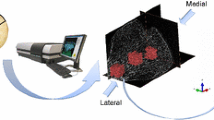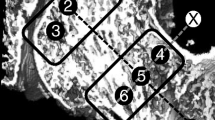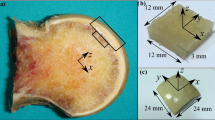Abstract
The regional microstructural variations in femoral head from proximal femoral fracture patients were investigated. Micro-CT scanning was performed on seven femoral heads from proximal femoral fracture patients. Each femoral head was divided into three regions according to the trabecular orientation from the fovea of femoral head to the femoral neck. Eight three-dimensional trabecular cube models were reconstructed from each region. A total of 154 trabecular cubic models were reconstructed because the corresponding areas for 14 cubic models were damaged during the surgeries. Eight trabecular morphological parameters were measured and analyzed, namely, trabecular thickness (Tb.Th), trabecular separation (Tb.Sp), specific bone surface (BS/BV), bone volume fraction (BV/TV), structural model index (SMI), degree of anisotropy (DA), trabecular pattern factor (Tb.Pf), and trabecular number (Tb.N). Bivariate correlation analyses were performed for all morphological parameters. One-way ANOVA tests were performed to analyze the differences of each parameter among three regions. Post-hoc multiple comparisons (Student-Newman-Keuls method) were performed to analyze the morphological difference between two regions. Trabecular bone of proximal femoral fracture patients significantly degenerated in all regions of femoral heads. BV/TV was statistically correlated with Tb.Th, Tb.Sp, BS/BV, Tb.Pf, and Tb.N (p < 0.05). Statistical differences in morphological parameters were observed between regions (p < 0.05). The trabecular strength in the middle regions was significantly higher than that in other regions because of the relationships between morphological parameters and mechanical parameters. Trabeculae in the medial region were more uniform and stable along each direction than those in the lateral region. Most trabeculae in the lateral region only grew along the weight-bearing direction, and those along the other directions degenerated significantly. This study provides detailed trabecular morphological information on fractured femoral heads, as well as references for the prevention of high fracture risk in the elderly.
Similar content being viewed by others
References
Kanis J A, Oden A, McCloskey E V, Johansson H, Wahl D A, Cooper C. A systematic review of hip fracture incidence and probability of fracture worldwide. Osteoporosis International, 2012, 23, 2239–2256.
Gullberg B, Johnell O, Kanis J A. World-wide projections for hip fracture. Osteoporosis International, 1997, 7, 407–413.
Kanis J A. Assessment of fracture risk and its application to screening for postmenopausal osteoporosis: Synopsis of a WHO Report. Osteoporosis International, 1994, 4, 368–381.
Pasco J A, Seeman E, Henry M J, Merriman E N, Nicholson G C, Kotowicz M A. The population burden of fractures originates in women with osteopenia, not osteoporosis. Osteoporosis International, 2006, 17, 1404–1409.
Aaron J E, Shore P A, Shore R C, Beneton M, Kanis J A. Trabecular architecture in women and men of similar bone mass with and without vertebral fracture: II. Three-dimensional histology. Bone, 2000, 27, 277–282.
Bouxsein M L. Mechanisms of osteoporosis therapy: A bone strength perspective. Clinical Cornerstone, 2003, S2, S13–S21.
Hochberg M C, Greespan S, Wasnich R D, Miller P, Thompson D E, Ross P D. Changes in bone density and turnover explain the reductions in incidence of nonvertebral fractures that occur during treatment with antiresorptive agents. Journal of Clinical Endocrinology Metabolism, 2002, 87, 1586–1592.
Cummings S R, Karpf D B, Harris F, Genant H K, Ensrud K, LaCroix AZ, Black DM. Improvement in spine bone density and reduction in risk of vertebral fractures during treatment with antiresorptive drugs. American Journal of Medicine. 2002, 112, 281–289.
Goulet R W, Goldstein S A, Ciarelli M J, Kuhn J L, Brown M B, Feldkamp L A. The relationship between the structural and orthogonal compressive properties of trabecular bone. Journal of Biomechanics, 1994, 27, 375–389.
Ulrich D, Rietbergen B V, Laib A, Ruegsegger P. The ability of three-dimensional structural indices to reflect mechanical aspects of trabecular bone. Bone, 1999, 25, 55–60.
Seeman E. Pathogenesis of bone fragility in women and men. Lancet, 2002, 359, 1841–1850.
Vale A C, Pereira M F C, Mauricio A, Amarai P, Rosa L G, Lopes A, Rodrigues A, Caetano-Lopes J, Viadal B, Monteiro J, Fonseca J E, Canhao H, Fatima M. Micro-computed tomography and compressive characterization of trabecular bone. Colloids and surfaces A: Physicochemical and Engineering Aspects, 2013, 438, 199–205.
Hilderband T, Liab A, Muller R, Dequeker J, Ruegsegger P. Direct three-dimensional morphometric analysis of human cancellous bone: Microstructural data from spine, femur, iliac crest, and calcaneus. Journal of Bone and Mineral Research, 1999, 14, 1167–1174.
Kanis J A. Diagnosis of osteoporosis and assessment of fracture risk. Lancet, 2002, 359, 1929–1936.
Wu Z H, Laneve A J, Niebur G L. In vivo microdamage is an indicator of susceptibility to initiation and propagation of microdamage in human femoral trabecular bone. Bone, 2013, 55, 208–215.
Nagaraja S, Couse T L, Gulderg R E. Trabecular bone microdamage and microstructural stresses under uniaxial compression. Journal of Biomechanics, 2005, 38, 707–716.
Arlot M E, Burt-Pichat B, Roux J P, Vashishth D, Bouxsein M L, Delmas P D. Microarchitecture influences microdamage accumulation in human vertebral trabecular bone. Journal of Bone and Mineral Research, 2008, 23, 1613–1618.
Zhang Z M, Li Z C, Jiang L S, Jiang S D, Dai L Y. Micro-CT and mechanical evaluation of subchondral trabecular bone structure between postmenopausal women with osteoarthritis and osteoporosis. Osteoporosis International, 2010, 21, 1383–1390.
Gonzalez-Garcia R, Monje F. Is micro-computed tomography reliable to determine the microstructure of the maxillary alveolar bone. Clinical Oral Implants Research, 2013, 24, 730–737.
Djuric M, Zagorac S, Milovanovic P, Djonic D, Nikolic S, Hahn M, Zivkovic V, Bumbasirevic M, Amling M, Marshall R P. Enhanced trabecular micro-architecture of the femoral neck in hip osteoarthritis vs. healthy controls: A micro-computer tomography study in postmenopausal women. International Orthopaedics, 2013, 37, 21–26.
Liu G M, Xu C J, Kong N, Zhu X M, Zhang X Y, Yao Y. Age-related differences in microstructure, density and biomechanics of vertebral cancellous bone of Chinese males. The Aging Male, 2012, 15, 233–239.
Turunen M J, Prantner V, Jurvelin J S, Kroger H, Isaksson H. Composition and microarchitecture of human trabecular bone change with age and differ between anatomical locations. Bone, 2013, 54, 118–125.
Isaksson H, Toyras J, Hakulinen M, Aula A S, Tamminen I, Julkunen P, Kroger H, Jurvelin J S. Structural parameters of normal and osteoporotic human trabecular bone are affected differently by microCT image resolution. Osteoporosis International, 2011, 22, 167–177.
Cui W Q, Won Y Y, Baek M H, Lee D H, Chung Y S, Hur J H, Ma Y Z. Age-and region-dependent changes in three-dimensional microstructural properties of proximal femoral trabeculae. Osteoporosis International, 2008, 19, 1579–1587.
Lochmuller E M, Matsuura M, Bauer J, Hitzl W, Link T M, Muller R, Eckstein F. Site-specific deterioration of trabecular bone architecture in men and women with advancing age. Journal of Bone and Mineral Research, 2008, 23, 1964–1973.
Li B, Aspden R M. Composition and mechanical properties of cancellous bone from the femoral head of patients with osteoporosis or osteoarthritis. Journal of Bone and Mineral Research, 1997, 12, 641–651.
Ohman C, Baleani M, Perilli E, Dall’Ara E, Tassani S, Baruffaldi F, Viceconti M. Mechanical testing of cancellous bone from the femoral head: Experimental errors due to off-axis measurement. Journal of Biomechanics, 2007, 40, 2426–2433.
Tanck E, Bakker A D, Kregting S, Cornelissen B, Klein-Nulend J, Van Rietbergen B. Predictive value of femoral head heterogeneity for fracture risk. Bone, 2009, 44, 590–595.
Mori S, Harruff R, Ambrosius W, Burr D B. Trabecular bone volume and microdamage accumulation in the femoral heads of women with and without femoral neck fractures. Bone, 1997, 21, 521–526.
Singh M, Nagrath A R, Maini P S. Changes in trabecular pattern of the upper end of the femur as an index of osteoporosis. Journal of Bone and Joint Surgery (Am.), 1970, 52, 457–467.
Stauter M, Rapillard L, Lenthe G H V, Zysset P, Muller R. Importance of individual rods and plates in the assessment of bone quality and their contribution to bone stiffness. Journal of Bone and Mineral Research, 2006, 21, 586–595.
Skedros J G, Baucom S L. Mathematical analysis of trabecular ‘trajectories’ in apparent trajectorial structures: The unfortunate historical emphasis in the human proximal femur. Journal of Theoretical Biology, 2007, 244, 15–45.
Liu X S, Sajda P, Saha P K, Wehrli F W, Bevill G, Keaveny T M, Guo X E. Complete volumetric decomposition of individual trabecular plates and rods and its morphological correlations with anisotropic elastic moduli in human trabecular bone. Journal of Bone and Mineral Research, 2008, 23, 223–235.
Brown S J, Pollintine P, Powell D E, Davie M W, Sharp C A. Regional differences in mechanical and material properties of femoral head cancellous bone in health and osteoarthritis. Calcified Tissue International, 2002, 71, 227–234.
Carter D R, Fyhrie D P, Whalen R T. Trabecular bone density and loading history: Regulation of connective tissue biology by mechanical energy. Journal of Biomechanics. 1987, 20, 785–787.
Nazarian A, Muller J, Zurakowski D, Muller R, Snyder B D. Densitometric, morphometric and mechanical distributions in the human proximal femur. Journal of Biomechanics. 2007, 40, 2573–2579.
Hahn M, Vogel M, Pompesius-Kempa M, Delling G. Trabecular bone pattern factor–A new parameter for simple quantification of bone microarchitecture. Bone, 1992, 13, 327–330.
Parkinson I H, Fazzalari N L. Interrelationships between structural parameters of cancellous bone reveal accelerated structural change at low bone volume. Joint of Bone and Mineral Research, 2003, 18, 2200–2205.
Stauber M, Rapillard L, van Lenthe G H, Zysset P, Muller R. Importance of individual rods and plates in the assessment of bone quality and their contribution to bone stiffness. Joint of Bone and Mineral Research, 2006, 21, 586–595.
Author information
Authors and Affiliations
Corresponding author
Rights and permissions
About this article
Cite this article
Lv, L., Meng, G., Gong, H. et al. Regional Variations in Trabecular Morphological Features of Femoral Head of Patients with Proximal Femoral Fractures. J Bionic Eng 12, 294–303 (2015). https://doi.org/10.1016/S1672-6529(14)60122-0
Published:
Issue Date:
DOI: https://doi.org/10.1016/S1672-6529(14)60122-0




